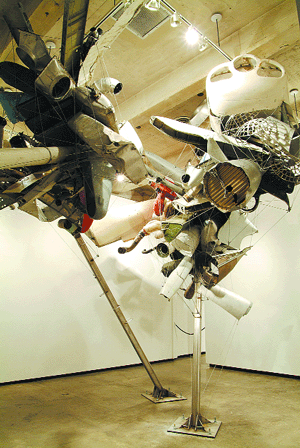Nancy Rubins shows diversity of her creativity with two disparate rooms of airplane parts
Sculptor Nancy Rubins returns to New York, showing her now-trademark airplane parts set aloft on armatures, filling the two large rooms at Paul Kasmin. Her prior work was factually titled, detailing her choice of materials—”Trailers and Hot Water Heaters,” “Mattresses and Cakes”—presenting huge accumulations tied up to each other by wire.
A big deal has been made and written about Rubins’ choice of materials. I’m more interested in what she does with the stuff once she gets it. “Small Forest” reveals the articulated internal metal skeleton to which her jet junk parts are bound, giving it a metaphoric significance very much like a child trying to pin dropped leaves back on the trees, only here the leaves are fuselages and engine housings.
You enter the gallery and confront two uprights that support Rubins’ materials in a highly dynamic explosio of parts that aggressively push out deeply to the very edges of the room. Never touching, the “trees” in this first room vibrate with tension and extension, imposing on you, forcing you to step aside—just as real trees do. You are in this grove and it is an aggressive, physically enveloping experience that goes giant steps beyond similar space engulfing installations of Judy Phaf and Jessica Stockholder. In this room, Rubins is traveling in the realm of Bontecou’s toothy voids, Kurt Schwitter’s “Merzbau” constructions and Frank Stella’s molten aluminum rooms.
Compositionally turning in on itself, the second room creates an experience similar to watching a pas de deux from a seat in the audience. I was very clearly put in my place as a witness rather than as a participant. The cantilevered supports that one might expect to be more energetic are, in fact, less so, with the tension between the two “trees” much less pronounced. The weight of the piece is up, overhead, and the dynamic is visual, not physical. The walk through experience is slack.
Pictorially, the piece functions best from outside, while you are standing in the corners of the room. The feeling of weightlessness and remove put me in mind of 18th -century pastoral prints, the rhythmic volumes and hollows of Rubins’ scrap metal parts are reduced to so much drawn froufrou—big tonnage froufrou, to be sure—but froufrou nonetheless. Rubins presents the same means and elements, but comes to vastly different ends in the two rooms, flexing her muscles to put on display the full range of her sculptural expression.
gaycitynews.com


































